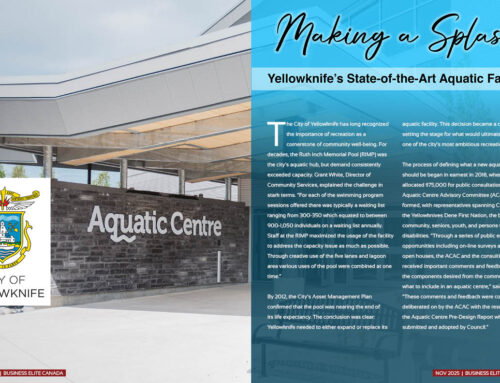At the heart of Hamilton’s commitment to modern, efficient, and sustainable transit is a major infrastructure investment years in the making: the new Transit Bus Maintenance Facility at 281 Birch Avenue. Designed to store, maintain, and fuel up to 200 buses, and with room for 100 more, this second major operations hub represents a significant leap forward for the City’s growing transportation network.
“We first identified the need for a second bus maintenance site in 2013,” says Maureen Cosyn Heath, Director of the City of Hamilton’s Transit Division. “Our current facility at 2200 Upper James Street was built in 1983 to house 200 buses, but today it’s hosting 258 standard buses, 11 small buses, and 49 articulated buses. The demand far exceeds its original design.”
Support Now and Into the Future
The new facility, valued at approximately $395 million, will not only relieve capacity pressures but serve as a launching pad for long-term transit expansion under the city’s upcoming plan, HSR Next: Moving Hamilton Forward. “This is a critical piece of infrastructure required not only to support the existing fleet, but to also handle more buses in the future,” says Cosyn Heath.
Spanning 23 acres in Hamilton’s lower city, the new centre will feature two indoor compressed natural gas (CNG) fuelling lanes, which is the first of their kind in Ontario. 30 maintenance bays, advanced bus washes, administrative offices, training facilities, and a 400-space employee parking structure are also included in the plan. The building is also designed with flexibility in mind, ready to accommodate future hydrogen or battery-electric buses.
“We wanted to build a facility that’s not just meeting today’s needs, but prepared for the future of transit,” she explains. “The design includes wider lanes for electric chargers, structural upgrades for overhead pantograph systems, and utilities connections scaled for 30 electric vehicles, with expansion options.”
The journey to construction has taken time. Land assembly and feasibility studies began in 2016, and the design process started in earnest in late 2017. Construction began in November 2023 and is on track to wrap up in the Spring of 2026.
“The pandemic certainly threw a wrench into our timeline,” says Cosyn Heath. “Finalizing design and procurement during COVID lockdowns brought new challenges, and once we reached the tender phase, we faced price escalations due to supply chain issues, inflation, and labour shortages.”
Despite the costs, the City chose to move forward. “Council ultimately approved financing the difference because they understood that without this facility, Hamilton transit couldn’t grow,” she adds. The project is backed by $111.4 million in federal and $92.6 million in provincial funding.
Several key players helped bring the project to life. Arcadis was retained as the Prime Design and Contract Management consultant, while Pomerleau serves as the General Contractor. The City’s Corporate Facility and Energy Division provided project management, while the Transit Division offered detailed operational expertise throughout the design process.
“We worked closely with our internal teams to make sure the facility met the needs of both today’s operations and tomorrow’s ambitions,” says Cosyn Heath. “This includes everything from safer bus access to staff amenities and future fuel readiness.”
Safety and Sustainability
Safety is a major design consideration on any project, and this was no exception. “One of the most thoughtful features is how the administrative building is elevated above the bus lanes, with employees entering from the parking structure across a walkway,” she explains. “It eliminates potential incidences between people and vehicle movement.”
Sustainability was also embedded into the project from the beginning. The site will not house or use diesel fuel and is purpose-built for CNG with space set aside for emerging low-emission technologies. A white roof helps reduce cooling volumes in the summer, and over 300 trees will be planted on the site. The parking structure also includes 20 EV chargers.
Additionally, the facility’s lower city location offers operational efficiency. “Right now, a lot of our routes start or end far from the mountain transit centre,” Cosyn Heath explains. “By operating from Birch Avenue, we can reduce deadhead travel, saving on fuel and cutting emissions.”
Immediate Impact
The proximity to the Metrolinx LRT operations centre also provides long-term integration opportunities as Hamilton expands its transit options.
The benefits for staff are just as important. “Operating at 85 per cent over capacity has taken patience,” says Cosyn Heath. “Staff have had to navigate limited parking andhoist availability, and tight maintenance schedules. Knowing a second facility is coming in 2026 is a major morale boost.”
From an operational standpoint, the impact will be immediate. “This facility will drastically improve service reliability and maintenance efficiency,” she says. “More space means better planning, faster turnarounds, and less wear and tear on both people and buses.”
On a personal note, Cosyn Heath reflects on the significance of leading such a transformative project. “There are people at the City who have worked on this for a decade and truly deserve their moment at the ribbon-cutting,” she says. “It’s been my pleasure to be a custodian of the project these past several years.”
She’s also quick to recognize the broader team: “I want to acknowledge the frontline staff who have worked hard within the space constraints. Watching this building take shape, knowing it will change how transit is delivered in Hamilton for decades, is very satisfying.”
Looking ahead, the Birch Avenue facility will be a cornerstone of HSR Next, the City’s forthcoming growth strategy. “This plan will add new routes and service types like on-demand transit to areas like Dundas, Waterdown, and Stoney Creek,” says Cosyn Heath. “That expansion isn’t possible without this facility.”
“Transit is never still—it must constantly evolve,” she concludes. “With population growth, environmental demands, and technological change, this new facility gives us the infrastructure we need to keep moving Hamilton forward.”
For more information, please visit www.hamilton.ca/environmental-assessments/hamilton-transit-bus-maintenance-storage-facility-design






